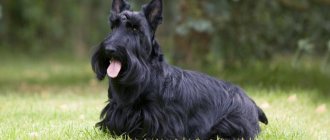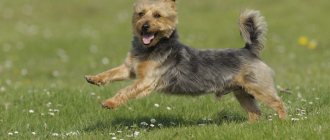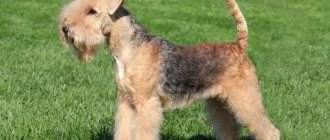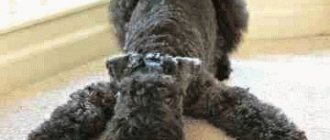| Patterdale Terrier | |
| Origin | |
| Place | England England |
| Time | 1960s |
| Characteristics | |
| Height | 25.4—38.1 cm |
| Weight | 5.4—9.1 kg |
| Wool | smooth or hard |
| Color | black, red, gray, black-brown, chocolate, bronze |
| Lifespan | 13-14 years old |
| Other | |
| Usage | hunting dog |
| Patterdale Terrier at Wikimedia Commons | |
The Patterdale Terrier
[1][# 1] (English patterdale terrier) is a breed of hunting dog, bred in the 1960s in England. It is used for hunting fox and badger in inaccessible mountainous areas; in the USA it is also used for hunting marmot, raccoon and nutria[1][3]. Not recognized by the International Canine Federation.
general characteristics
Looking at her, you might think that this is a small lap dog. Patterdale is a terrier, although he is not large in size, but the hunting instinct remains in his blood. The British hunter enjoys hunting foxes, badgers and raccoons. A brave and fearless dog drives the animal out of the hole or climbs into the hole himself and kills the animal on the spot, and then pulls it to the surface.
This breed has two types of coat. Patterdales come in smooth and wire-haired varieties, which are very similar to German terriers. Externally they look like this:
- Wide head.
- Small, triangular, hanging ears.
- Strong neck and strong jaws.
- Powerful physique.
- Well developed muscles.
- The body is flexible so that it can easily climb into holes.
- The coat is short and rough.
- The tail is in a vertical position and set high (the size of the tail is the palm of a person). The tail and ears are not docked.
- Color range: black, red or chocolate (there is a white spot on the chest).
- At the withers it reaches approximately 30.5 cm.
- The weight of an adult dog is 5-6kg.
- Life expectancy is up to 15 years.
Hunting dog Patterdale Terrier
The Patterdale Terrier is a working hunting dog bred in England back in the 18th century. Officially recognized since 1912. The breed was bred for hunting underground, this was reflected in its appearance and character. Dogs are still used for their original purpose. They require good training and education and are suitable for experienced dog breeders.
Description of the breed
The size of the Patterdale Terrier is small, which fully corresponds to the purpose of its breeding. They are harmoniously built, with well-developed muscles. When breeding, the main attention was paid to working qualities, which is why their appearance is still varied. Here is a brief description of the breed:
- The height of the dog at the withers is 30-38 cm
- Dog weight – 6-9 kg
- The head is regular in shape, wide, with a flat forehead
- The muzzle is not very long, but wide, with powerful jaws
- The nose is always black
- Ears are triangular and drooping
- The eyes are medium, expressive
- The body is compact, with well-developed muscles
- The breast is small, should be grasped by two palms of the owner
- The paws are powerful and wide.
The Patterdale Terrier comes in both smooth-haired and wire-haired varieties. Today several colors are recognized:
- Black
- Chocolate
- Ginger
- Wheat
- Black and Tan
- Redhead with gray hair.
Despite this variety of colors, the majority of Patterdale Terriers, about 95%, are black. You can easily verify this by looking at photos of these dogs on websites.
Character of the breed
The Patterdale Terrier is a typical hunting dog. Very active, requires long walks. The dog's character is quite aggressive, primarily towards other animals, especially small rodents. He is attached to his owner and gets along well with children over seven years old and teenagers. He has a ringing voice, barks for any reason, and warns of danger. She loves to crawl, because the main purpose of the dog is to chase game in its hole.
The dog is temperamental, a little stubborn, but at the same time has high intelligence. He is well trained in commands and should be trained by experienced owners or professional trainers. You need to start training from an early age, otherwise the dog will grow up poorly controlled. The Patterdale Terrier is best suited to being kept in an outdoor kennel. He is too active for an apartment or house.
The dog requires increased attention; she loves to be aware of all events. Left alone, he gets bored and becomes depressed. If the energy is not allowed to escape, she can “deal with” all the things that come under her teeth, and begins to dig the ground in the enclosure. It’s easy to get lost in the excitement of the hunt; if you walk a terrier in the city, he may run away and not respond to the owner’s call.
Care and nutrition
Caring for a dog is simple. The coat is combed once a week with a stiff brush to prevent tangles from forming. After walking or hunting, if the dog is dirty, you can bathe him. The Petterdale Terrier tolerates any weather conditions well. But in severe frosts, it is better to take a dog that lives outside into the house. First of all, this applies to the short-haired version of the breed. The ears are regularly inspected and cleaned if necessary. After walking in the forest, you need to check whether ticks have clung to the terrier’s body. When keeping the dog outdoors or using the dog for hunting, claw trimming is not required.
The Patterdale Terrier is unpretentious when it comes to food. It can be fed with both natural food and prepared food. When feeding naturally, the diet should be dominated by lean meat, preferably raw or scalded with boiling water. They also give offal a couple of times a week (tripe, liver, lungs, heart, etc.). The dog’s diet also includes vegetables and cereals. Buy high-quality dry food; cheap options are harmful even for such an unpretentious dog. Canned food is given from time to time; it should not form the basis of the diet.
Character
Such an active dog is suitable for active and patient people . It is better for the elderly not to purchase a Patterdale, as they physically cannot cope with it. He cannot sit in one place for a minute; the “little energizer” is in perpetual motion. They love to dig the ground. Therefore, this breed is contraindicated for gardeners and gardeners.
They are brave dogs and at the sight of any animal (which, in their opinion, looks like prey) they will want to grab it. They must always be kept firmly on a leash. They run fast, if they break free it will be difficult to catch up with them. Therefore, it is important to teach him to unquestioningly carry out the “come to me” command.
Patterdales are independent dogs, but this does not mean at all that they do not love their owner. They are jealous of other animals in the house. They have a chance to make friends with them if they grow up together from childhood.
These hunters love to be praised for following a command. Little fidgets need regular physical activity. Don't leave him alone in the house. Out of boredom, he can chew furniture, shoes, and wires. You need to walk with him every day, for at least two hours. Patterdale cannot be kept in an apartment, only a closed and spacious yard, that’s what they like. They are excellent guards .
Not recommended for families with small children . Difficult to train. They cannot concentrate their attention on one thing. If a dog or cat suddenly runs past, there is a chance that they will immediately run after it. Training will take a lot of time. You can leave it in the hands of a professional. It is better to train a dog from puppyhood. They are suitable only for those people who are ready to devote maximum of their free time to her.
Pros and cons of the breed
Patterdale Terriers have the following strengths/weaknesses:
| + | — |
| Agility, speed, maneuverability | Excessive activity |
| Devotion, recognition of the authority of the owner | It's hard to live in apartments |
| Inconsistency in food | Doesn't get along with other pets |
| Endurance, are working class dogs | Cannot tolerate rodents, considers them as a target |
| Does not require special care | They often bark loudly at the slightest danger. |
| Are in good health |
Care
There are no particular problems in caring for the Patterdale. The coat is not capricious and does not require much care. Their hair is short and it is enough to comb it once a week with a special brush, which can be purchased at a specialized store. This allows you to get rid of excess hair. Since they love to dig, their paws must be checked for microcracks and skidding every day. Wash as necessary, but only with special shampoo.
Clean your ears once a week with cotton swabs and pads soaked in a special veterinary lotion. You can trim your claws as needed. They grind them down well themselves.
Eye care is extremely important. For preventative purposes, you can wipe with weakly brewed tea or chamomile infusion, as well as products purchased at a veterinary pharmacy.
History of the breed
This variety of terrier was named after the village in which it was bred - Patterdale. The main purpose was hunting. Local residents of the surrounding areas of Great Britain made a living by catching foxes and badgers, whose fur is valued to this day. The hunting breed of terriers helped them in their work. The dogs were perfect for the needs of local residents; they were hard workers, small in size, ate little, and did not require special care. There was no emphasis on appearance; breeders did not need a decorative, but a practical, working breed.
Their ancestors are local dog breeds, including bull terriers. Accurate information about the family tree of Patterdale Terriers has not been preserved.
Several centuries later, the first exhibitions of the breed began to appear. Despite their relatively unpresentable appearance, Patterdale Terriers are loved by the public. Due to their intelligence, character, and abilities, they are distributed throughout the world.
Nutrition
Nutrition should be balanced. When feeding your dog dry food, choose only premium or luxury food. If the food is natural, it is very important that it is as balanced as possible. Monitor the content of calcium, proteins and carbohydrates in it. Therefore, we must not forget to give special poly-vitamins with food. We must remember that they are still predators and their diet must include more meat. You can feed the terrier:
- Boiled vegetables with meat, where meat should predominate approximately 60%, vegetables: carrots, zucchini, pumpkin, cauliflower, broccoli.
- Cereals: preferably rice or buckwheat + meat 60%
- Fermented milk products: kefir, cottage cheese, yogurt.
- Boiled sea fish.
You cannot feed pork, chicken bones, fish bones, river fish, legumes, semolina, flour and sweets.
Where to buy and price
Average price 12,000-20,000 rubles. The Patterdale Terrier is not very common in Russia, so it is difficult to find a kennel that has such puppies in stock. One of the kennels offering Patterdale Terrier puppies is JUTA HOUSE. You can also contact the Smirnov canine service, which offers its services in finding the required breed. In other countries there are professional kennels dedicated to breeding a specific breed of terrier. If possible, you can seek their services.
Patterdale Terriers have an interesting history. This working breed, not distinguished by its attractive appearance, was able to win the hearts of many dog lovers. Despite the lack of official recognition, the breed standard dictates the rules that breeders adhere to. These hunting pets get along with people and are distinguished by loyalty, intelligence, and endurance.
Our gallery











